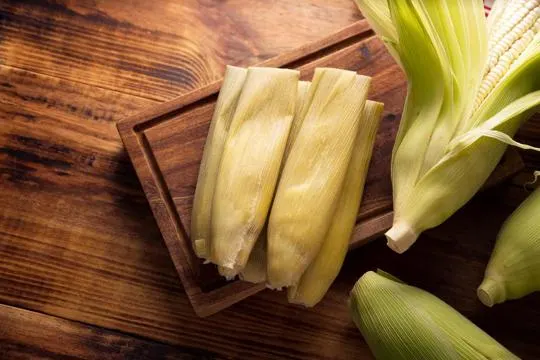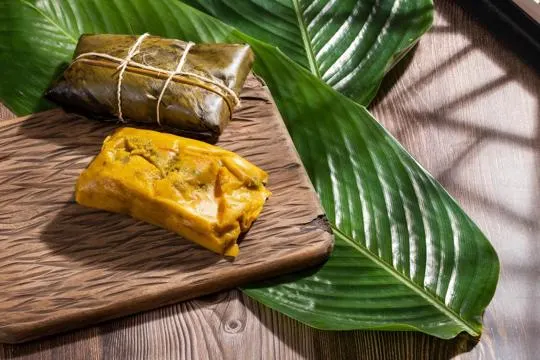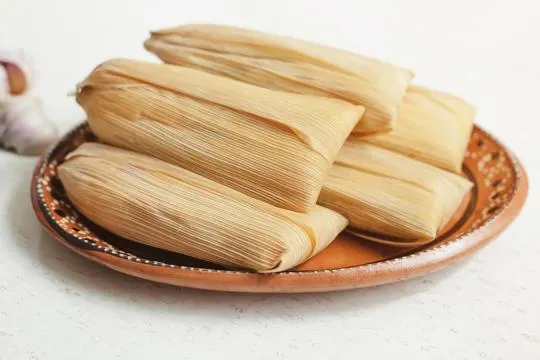In the great food face-off, hallacas and tamales take center stage. What sets them apart? We’ve got the scoop.
Both hail from Latin America, yet they’re as different as night and day. Hallacas, a Venezuelan holiday staple, wrap their magic in banana leaves. Tamales, on the other hand, prefer the snug hug of corn husks.
I still remember my first hallaca; it was like unwrapping a present on a plate. Tamales, though? A weekly delight in our home. Each has its own flavor orchestra, playing tunes that dance on the taste buds.
Now, we’re laying it all out for you.
What are Hallacas?

Hallacas, from Venezuela, are far more than a traditional dish.
These delicious treats embody the country’s cultural heritage.
During special occasions such as Christmas and Easter, families and friends come together to enjoy the flavors of hallacas.
Creating hallacas involves wrapping a mixture of seasoned beef/pork, capers, raisins, olives, onions, garlic, peppers, and spices in masa, a corn dough.
The filling may differ region to region and family to family, but the flavor is still the same – a delightful mix of tastes.
Banana leaves are used to cover the filled parcel before it’s secured with twine or string.
This adds flavor and aroma to the dish as it cooks slowly for several hours.
Hallacas are traditionally boiled or steamed.
They spend hours immersed in simmering water or placed over hot coals.
This slow-cooking process ensures all the flavors blend together while keeping the fillings tender.
Hallacas are artistically presented – each one is wrapped into an envelope or bundle shape tied with string.
People like different shapes – some prefer rectangular, while others opt for triangular.
What are Tamales?

Tamales – a Mexican delicacy.
Masa dough filled with meats, cheese and veggies, all wrapped up in corn husks and steamed.
Making tamales is an art passed down through generations with unique twists in each region.
The magic of tamales lies in the flavors and textures.
Soft and sweet masa dough, subtle earthy aroma from the corn husk.
Fillings range from pork to spicy chicken, even veggie-friendly options.
Tamale-making is a communal experience.
Families and friends gather to make large batches.
This creates unity and bonding as everyone contributes their skills.
Tamales require time, patience and attention to detail.
Soaking the corn husks, wrapping each tamale carefully, and the steaming process to ensure the flavors meld and the masa dough is cooked through.
Differences Between Hallacas and Tamales

Hallacas and tamales have distinct differences, even though they may appear similar.
Origin and Cultural Background
Hallacas and tamales are two iconic dishes that share similarities in their preparation and cultural importance.
Hallacas are a Venezuelan dish with roots in colonization, made with maize dough (masa) and filled with beef or pork, olives, raisins and spices, before being wrapped in plantain leaves and cooked.
Tamales have a long history, dating back to ancient Mesoamerican civilizations.
Tamales are made by spreading masa onto corn husks or banana leaves, filling them with meats, cheese, vegetables or chili peppers, folding and steaming.
Though both hallacas and tamales feature similar techniques, they differ in terms of ingredients and fillings.
Hallacas have a more complex flavor due to the combination of spices, while tamales vary regionally in terms of flavors and ingredients used.
Mexican tamales, for example, may contain jalapenos and chocolate, while Central American tamales may contain potatoes or rice.
Wrapper or Outer Layer
Hallacas and tamales have an outer layer that is key to their flavor and texture.
It is a protective cover that keeps all the flavors in and gives each dish its own special touch.
Hallacas, a Venezuelan dish, are usually wrapped in plantain leaves.
These leaves give it a pleasant aroma and add subtle flavors.
Hallacas have a unique taste and look because of this.
In contrast, tamales from Mexican cuisine are often covered in corn husks or banana leaves.
These wrappers add to the flavor of the tamale, making it savory.
They also give tamales a rustic appearance.
Hallacas and tamales have similar wrapping before cooking.
But, they use different wrappers.
Plantain leaves give a tropical feel to hallacas, while corn husks or banana leaves bring the Mexican spirit to tamales.
Fillings and Ingredients
Fillings and ingredients are key in distinguishing Hallacas from Tamales.
Hallacas are from Venezuela, while Tamales come from Mexico.
Hallacas have a mix of meats such as beef, pork, and chicken.
Plus, olives, raisins, capers, bell peppers, onions, garlic, and herbs/spices.
All wrapped in corn dough made from maize flour.
Tamales usually contain shredded meat, cheese, beans, or vegetables.
Enveloped in masa dough made from cornmeal or masa harina.
Both dishes showcase the cultural diversity & culinary creativity of their regions.
Hallacas have rich/complex flavors from savory meats & aromatic herbs/spices.
Tamales are versatile with a wide range of fillings to suit different tastes.
Hallacas and Tamales also differ in cooking methods.
Both are steamed until cooked through.
Hallacas need longer cooking time.
Also, wrapper techniques are different.
Hallacas are wrapped in plantain leaves, then tied with strings/banana leaf strips.
Tamales are wrapped in corn husks/banana leaves using folding techniques.
Both dishes bring people together.
They are often enjoyed at special gatherings.
Friends & family savor the unique flavors & share in joy of communal dining.
Cultures are celebrated & traditions upheld.
Appreciate the history & heritage within each bite – whether a Hallaca or Tamale.
Flavor and Seasonings
Hallacas and tamales have their own unique flavor and seasonings.
Each dish has a special blend of herbs and spices that tantalize the taste buds.
Hallacas from Venezuela have a rich, complex flavor.
They use beef or pork, chicken, olives, raisins, and capers in the filling.
This is cooked with onions and garlic, seasoned with cumin, paprika, and oregano.
Annatto seeds are also added for a vibrant color.
It is then wrapped in maize dough made from cornmeal masa and boiled or steamed.
Tamales have Mexican roots and the filling can vary.
It often contains chicken or pork mixed with onions and peppers.
The spices used are chili powder, cumin, garlic powder, and Mexican oregano.
Tamales are wrapped in corn husks or banana leaves before being steamed or boiled.
These two dishes are different due to their spice combinations.
They both use garlic and cumin but have their own signature flavorings.
Whether you like Venezuelan hallacas or Mexican tamales is up to you.
Cooking Techniques
Cooking techniques have a major part in making distinct flavors and textures of different dishes.
When it comes to Hallacas and Tamales, these cooking approaches make a big difference.
To begin, steaming is common for both dishes.
Ingredients like marinated meats, veggies and masa, which is a corn dough, are put inside banana leaves or corn husks.
The packages are then tied up, put in a steamer or pot full of boiling water.
The steam cooks the ingredients slowly and evenly, giving tender and flavorful Hallacas and Tamales.
Simmering is also essential.
After being assembled and firmly secured, they are submerged in a pot of broth or seasoned liquid.
This pot is heated on low heat to maintain a gentle simmer.
Simmering lets the flavors mix and assures that the masa cooks properly without becoming hard or dry.
Though there are common cooking techniques between Hallacas and Tamales, they differ slightly.
Hallacas require more time to cook due to the complex mix of ingredients.
On the other hand, Tamales only need a shorter cooking time since they usually have simpler fillings.
Similarities Between Hallacas and Tamales

Hallacas and tamales are two Latin American dishes with striking similarities.
Masa, a corn-based dough, is used to make both.
Inside the dough are various ingredients like meat, vegetables, or cheese.
Wrapped in banana leaves or corn husks, they are steamed or boiled to perfection.
Though from different countries—Venezuela and Mexico—they represent the cultural heritage of their regions.
Families and communities come together to enjoy them during special occasions and holidays.
Hallacas and tamales have distinct features.
Hallacas often have a complex filling with beef, pork, chicken, or fish.
Plus, the dough requires annatto for seasoning and a vibrant orange color.
Additionally, the meat filling needs to marinate for hours or overnight for flavor.
In contrast, tamales offer more options.
Filling choices consist of chicken or pork, as well as vegetarian options with vegetables or cheese.
Serving and Eating Traditions
Hallacas and tamales have deep roots in their respective regions’ culinary cultures.
Their serving and eating styles are more than just different ingredients and methods – they have great importance.
These delicacies are often shared at celebrations, symbolizing unity.
They’re usually wrapped in banana leaves or corn husks for added flavor and looks.
This ancient practice preserves the authentic taste.
Hallacas, typically from Venezuela, are eaten as a meal on special occasions like Christmas or weddings.
They are enjoyed with accompaniments like avocado, black beans, and a spiced sauce called ají.
The size of hallacas makes them perfect for sharing with others.
Tamales have variations across different countries.
For instance, in Mexico, they’re often topped with salsas and in Guatemala, eaten with coffee for breakfast or as a snack during lunch.
The one common trait these dishes share is that they represent centuries-old cultural heritage.
They are reminders of customs passed down through generations.
So when you eat hallacas or tamales, you’re not just tasting delicious flavors, but partaking in a tradition that unites people around the world.
Conclusion
After studying the distinct differences between hallacas and tamales, it’s easy to see why people are often confused.
Both dishes use a corn-based outer wrapper to contain a mix of meat and vegetables, making them relatively similar in appearance.
But when it comes to flavor they could not be more different—hallacas being savory with traces of olives while tamales have more complex flavors thanks to their sweet fillings.
All in all, no matter what your preference is, both hallacas and tamales make for delicious winter meals that bring friends and family together in celebration of tradition and culture during the holiday season.
Even those less familiar with Central or South American traditional cuisine can learn to appreciate the unique flavor combinations presented in this warm-hearted way of eating.
So go forth and explore these two engaging dishes—we promise you’ll be glad you did.

Leave a comment